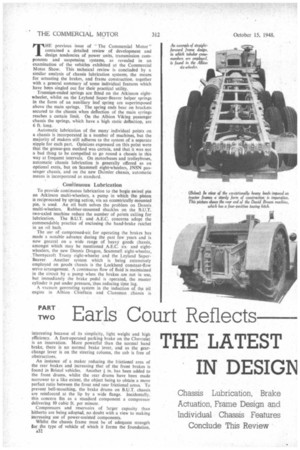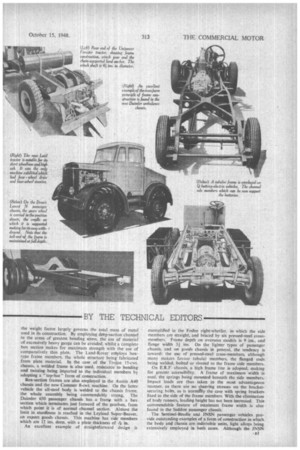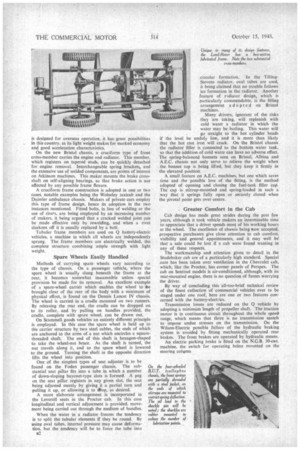PART TWO
Page 34

Page 35

Page 36

If you've noticed an error in this article please click here to report it so we can fix it.
Earls Court Reflects THE LATEST IN DESIGN
Chassis Lubrication, Brake Actuation, Frame Design and Individual Chassis Features Conclude This Review
THE previous issue of "The Commercial Motor" contained a detailed review of development and design tendencies of power units, transmission components and suspension systems, as revealed in an examination of the vehicles exhibited at the Commercial Motor Show. This technical review is concluded by a similar analysis of chassis lubrication systems, the means for actuating the brakes, and frame construction, together with a general summary of some individual features which have been singled out for their practical utility.
Trunnion-ended springs are fitted on the Atkinson eightwheeler, whilst on the Leyland Super-Beaver helper springs in the form of an auxiliary leaf spring are superimposed above the main springs. The spring ends bear on brackets secured to the chassis when deflection of the main springs reaches a certain limit. On the Albion Viking passenger chassis the springs, which have a high static deflection, are 6 ft. long.
Automatic lubrication of the many individual points on a chassis is incorporated in a number of machines, but the majority of makers still adheres to the system of a separate nipple for each part. Opinions expressed on this point were that the grease-gun method was certain, and that it was not a bad thing to be compelled to go round a chassis in this way at frequent intervals. On motorbuses and trolieybuses, automatic chassis lubrication is generally offered as an optional extra, but on Scammell eight-wheelers, Es/5'N passenger chassis, and on the new Daimler chassis, automatic means is incorporated as standard.
Conlinuous Lubrication
To provide continuous lubrication to the bogie swivel pin on Atkinson multi-wheelers, a pump in which the piston is reciprocated by spring action, via an eccentrically mounted pin, is used An oil bath solves the problem on Dennis multi-wheelers. Rubber-mounted shackles on the B.U.T. two-axled machine reduce the number of points calling for lubrication. The B.U.T. and A.E.C. concerns adopt the commendable practice of enclosing the hand-brake ratchet in an oil bath.
The use of compressed-air for operating the brakes has made a notable advance during the past few years and is now general on a wide range of heavy goods chassis, amongst which may be mentioned A.E.C, six and eightwheelers, the new Dennis Dragon, Scammell eight wheeler, Thornycroft Trusty eight-wheeler and the Leyland SuperBeaver Another system which is being extensively employed on goods chassis is the Lockheed constant-flow servo arrangement. A continuous flow of fluid is maintained in the circuit by a pump when the brakes are not in use, but immediately the brake pedal is operated, the master cylinder is put under pressure, thus reducing time lag.
A vacuum generating system in the induction of the oil engine in Albion Chieftain and Clansman chassis is interesting because of its simplicity, light weight and high efficiency. A foot-operated parking brake on the Chevrolet is an innovation. More powerful than the normal hand brake, there is no normal brake lever, and as the gearchange lever is on the steering column, the cab is free of obstructions.
An instance of a maker reducing the frictional area of the rear brakes and increasing that of the front brakes is found in Bristol vehicles. Another in. has been added to the front drums, whilst the rear drums have been made narrower to a like extent, the object being to obtain a more perfect ratio between the front and rear frictional areas. To prevent bell-mouthing, the brake drums on B.U.T. chassis are reinforced at the lip by a wide flange. Incidentally. this concern fits as a standard component a compressor delivering DO cubic ft. per minute.
Compressors and reservoirs of larger capacity than hitherto are being adopted, no doubt with a view to making increasing use of power-assisted components.
Whilst the chassis frame must be of adequate strength for the type of vehicle of which it forms the foundation, A32 the weight factor largely governs the total mass of metal used in its construction. By employing deep-section channel in the areas of greatest bending stress, the use of material of excessively heavy gauge can be avoided, whilst a complete box section makes for maximum strength with the use of comparatively thin plate. The Land-Rover employs boxtype frame members, the whole structure being fabricated from plate material. In the case of the Trojan 15-cwt. chassis, a welded frame is also used. resistanee to bending and twisting being imparted to the individual members by adopting a "top-hat" form of construction.
Box-section frames are also employed in the Austin A40. chassis and the new Cornmer 8-cwt. machine. On the latter vehicle the all-steel body is welded to the chassis frame. the whole assembly being commendably strong. The Daimler 650 passenger chassis has a frame with a box section which terminates just forward of the gearbox, from which point it is of normal channel section. Almost the limit in sturdiness is reached in the Leyland Super-Beaver, an export goods chassis. This machine has side members which are 12 ins. deep, with a plate thickness of A in
An excellent example of straightforward design is exemplified in the Foden eight-wheeIer, in which the side members are straight, and braced by six pressed-steel crossmembers. Frame depth on overseas models is 9 ins., and flange width 31 ins. On the lighter types of passenger chassis, and on goods chassis in genetal, the tendency is towards the use of pressed-steel cross-members, although many makers favour tubular members, the flanged ends being welded_ bolted or riveted to the frame side members.
On E.R.F. chassis, a high frame Line is adopted. making for greater accessibility. A frame of maximum width is used, the springs being mounted beneath the side members. Impact loads are thus taken in the most advantageous manner, as there are no sheering stresses on the bracketsecuring bolts, as is normaqty the case with spring brackets fixed to the side of the frame members. With the elimination of body runners, loading height has not been increased. This commendable feature of maximum frame width is also found in the Seddon passenger chassis.
The Sentinel-Beadle and JNSN passenger vehicles provide outstanding examples of a form of construction in which the body and chassis are indivisible units, light alloys being extensively employed in both cases. Although the JNSN is designed for overseas operation, it has great possibilities in this country, as its light weight makes for marked economy and good acceleration characteristics.
On the new Bristol chassis, a cruciform type of front cross-member carries the engine and radiator. This member, which registers on tapered studs, can be quickly detached for engine removal. Interchangeable spring brackets. and the extensive use of welded components, are points of interest on Atkinson machines. This maker mounts the brake crossshaft on self-aligning bearings, so that brake action is not affected by any possible frame flexure.
A cruciform frame construction is adopted in one or two cases, notable examples being the Wolseley taxicab and the Daimler ambulance chassis. Makers of private cars employ this type of frame design, hence its adoption in the two instances mentioned. Fitted bolts, in lieu of welding or the use of rivets, are being employed by an increasing number of makers, it being argued that a cracked welded joint can be made effective only by rewelding, and when a rivet slackens off it is usually replaced by a bolt.
Tubular frame members are used on Q battery-electric vehicles, a machine in which all wheels are independently sprung. The frame members are electrically welded, the complete structure combining ample strength with light weight.
Spare Wheels Easily Handled Methods of carrying spare wheels vary according to the type of chassis. On a passenger vehicle, where the spare wheel is usually slung beneath the frame at the rear, it becomes somewhat inaccessible unless special provision be made for its removal. An excellent example of a spare-wheel carrier which enables the wheel to tbe brought clear of the rear of the body with a minimum of physical effort, is found on the Dennis Lancet IV chassis. The wheel is carried in a cradle mounted on two runners. By releasing the rear end, the cradle can be dropped on to its roller, and by pulling on handles provided, the cradle, complete with spare wheel, can be drawn out.
On Scammell goods vehicles an entirely different principle is employed. In this case the spare wheel is held up to the carrier structure by -two steel cables, the ends of which are anchored to the arms of a nut which encircles a squarethreaded shaft. The end of this shaft is hexagon-shaped to take the wheel-nut brace. As the shaft is turned, the nut travels along it, and so the spare wheel is lowered to the ground. Turning the shaft in the opposite direction lifts the wheel into position.
One of the simplest types of seat adjuster is to be found on the Foden passenger chassis. The substantial seat pillar fits into a tube in which a number of down-sloping bayonet-type slots is formed. A peg on the seat pillar registers in any given slot, the seat being adjusted merely by giving it a partial turn and pulling it up, or allowing it to mop, as desired.
A more elaborate arrangement is incorporated in the Leveroll seats in the Proctor cab. In this case longitudinal and vertical adjustment is provided, movement being carried out through the medium of handles.
When the water in a radiator freezes the tendency is to split the tubular elements if they be round. By using oval tubes, internal pressure may cause deformation, but the tendency will be to force the tube into
circular formation. In the TillingStevens radiator, oval tubes are used, it being claimed that no trouble follows ice formation in the radiator. Another feature of radiator design, which is particularly commendable, is the filling arrangement adopted on Bristol machines.
Many drivers, ignorant of the risks they are taking, will replenish with cold water a radiator in which the water may be boiling. This water will
go straight to the hot cylinder heads if the level be unduly low, and it is more than likely that the hot cast iron will crack. On the Bristol chassis the radiator filler is connected to the bottom water tank, so that the addition of cold water can have no adverse effect. The spring-balanced bonnets seen on Bristol, Albion and A.E.C. chassis not only serve to relieve the weight when the bonnet top is being lifted, but they keep it firmly in the elevated position.
A small feature on A.E.C. machines, but one which saves time and the possible loss of the fitting, is the method adopted of opening and closing the fuel-tank filler cap. The cap is stirrup-mounted and spring-loaded in such a way that it springs fully open or securely closed when the pivotal point gets over centre.
. Greater Comfort in the Cab Cab design has made great strides during the past few years, although it took vehicle makers an interminable time to appreciate that a driver spends most of his working hours at the wheel. The excellence of chassis being flow accepted, prospective purchasers give close attention to cab comfort, visibility and general appointments, and it may well be that a sale could be lost if a cab were found wanting in any of these respects.
The workmanship and attention given to detail in the Studebaker cab are of a particularly high standard. Special .care has been taken over ventilation in the Chevrolet cab, which, like the Proctor, has corner panels of Perspex. The cab on Sentinel models is air-conditioned, although, with its rear-mounted engine, there is no question of fumes worrying the driver.
By way of concluding this all-too-brief technical review of the finest collection of commercial vehicles ever to be staged under one roof, here are one or two features concerned with the battery-electrics.
Transmission losses are reduced on the Q vehicle by adopting a minimum length of propeller shaft. The traction motor is in continuous circuit throughout the whole speed range, which means that there is no transmission snatch to impose undue stresses on the transmission. On the Wilson-Electric possible failure of the hydraulic braking system is avoided by fitting mechanically operated rear brakes. The front brakes are operated by hydraulic means.
An electric parking brake is fitted on the N.C.B. 30-cwt. machine, the switch for operating beine mounted on the steering column.




















































































